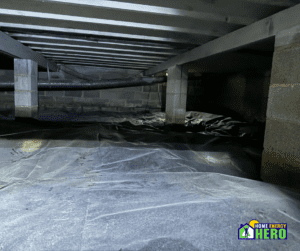
In the world of home construction and maintenance, understanding the different types of crawl spaces can significantly impact the health and efficiency of your home. Today, we’re diving into the three primary types of crawl spaces. Passive Crawl Spaces are OK, Encapsulated Crawl Spaces are BEST, and Hybrid Crawl Spaces are WRONG. Each have unique characteristics, benefits, and drawbacks.
Passive Crawl Spaces – OK
Passive Crawl Spaces are traditional, utilizing outside vents for air circulation. Insulation is typically placed on the ceiling of these crawlspaces. The major advantage of a passive crawlspace is its ability to keep crawl air out of the home, particularly beneficial in wet or humid climates. However, challenges such as the potential for insulation to fall, humidity affecting ductwork, and the risk of moisture and mold issues due to improper venting can arise. These cons highlight the importance of ensuring insulation is securely in contact with the subfloor and that venting is correctly managed to avoid wood rot and indoor air quality issues.
Encapsulated Crawl Spaces – BEST
Encapsulated Crawl Spaces, often considered the gold standard, transform the crawlspace into a mini-basement. This method involves using a sealed vapor barrier and insulating the walls, effectively sealing moisture and temperature fluctuations out of the home’s envelope. Benefits include reduced air leakage, the possibility of using the space for storage, and not needing to insulate ductwork in this semi-conditioned space. However, the encapsulation process can be more expensive initially. If retrofitting, it requires sufficient height for proper access. Incorrect encapsulation can lead to serious issues such as radon, mold, and moisture intrusion.
Hybrid Crawl Spaces – WRONG
Hybrid Crawlspaces are identified as the incorrect approach. They include mixing elements of both passive and encapsulated methods without fully committing to either. This inconsistency can lead to several problems. Understanding the different types of crawl spaces can help you see why. Unsealed or inadequately thin vapor barriers, lack of insulation on walls or ceilings, and the improper sealing of crawl space vents may result in metal ducting being left in non-insulated walls.
Conclusion
When we’re inspecting or considering crawlspace solutions, we find it crucial to look for signs of a well-designed system. This includes a properly sealed vapor barrier, adequate insulation on walls or ceilings in contact with the subfloor above, and appropriately managed crawl space vents. Try avoiding the pitfalls of a Hybrid system by choosing a correctly implemented Passive or Encapsulated crawl space can protect your home from moisture, mold, and structural issues. This will ensure a healthier living environment. We’re here to guide you in understanding the different types of crawl spaces. We are experts at selecting and maintaining the best crawl space solution for your home. We will ensure it remains safe, efficient, and comfortable for years to come.
If you’re ready to schedule a home energy audit and explore crawl space solutions, please contact us.
